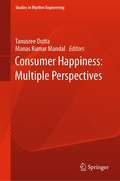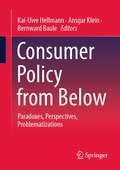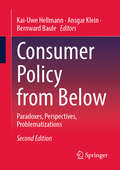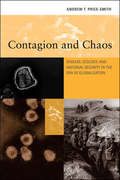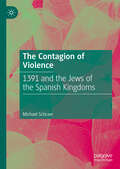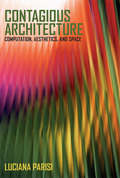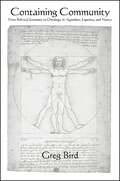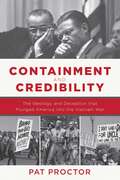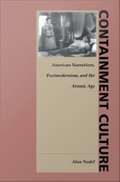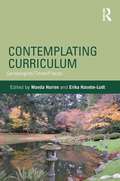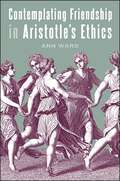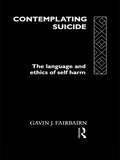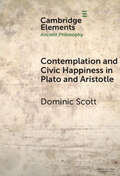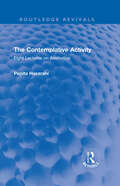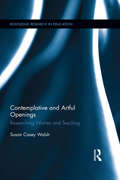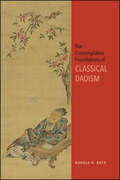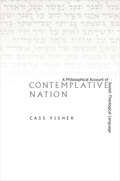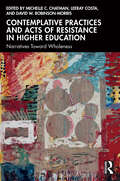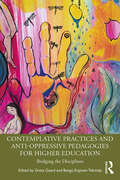- Table View
- List View
Consumed: How Markets Corrupt Children, Infantilize Adults, and Swallow Citizens Whole
by Benjamin R. BarberHow advertising and marketing seek to keep adults thinking like children and seek to advertise to children as if they are able to make choices as independent consumers.
Consumer Happiness: Multiple Perspectives (Studies in Rhythm Engineering)
by Tanusree Dutta Manas Kumar MandalThis book helps quench the quest of knowledge of academicians, researchers, and others interested in developing a complete and critical understanding of consumer happiness. The relentless search of happiness by humans is sought in different ways. Scientific discussion on happiness for long was considered a forte of Philosophers. Other disciplines seldom delved into this. But today not only science but neuroscience, marketing, and other varied fields have started delving into it and have developed a keen interest. The book has been conceptualized on this line of thinking and thus divided into two parts. The first part is customized towards understanding various perspectives of happiness and the relative importance of knowing the same. The first chapter of this section is on the biological perspective of happiness. The second is titled ‘Behavioural perspective’. The third chapter is an attempt to elucidate the cultural perspective of the concept of happiness. The fourth is on the role of technology in inducing happiness. Fifth and sixth are on theories of happiness and measuring happiness, respectively. Knowledge about the different perspective and theories has a wide range of benefits. It informs us about how the brain works, interprets, and reacts. This theoretical understanding helps us to move beyond the trial and error methods towards a more scientific underpinning of adoption of measures that would generate long-lasting happiness in consumers.The second part of the book is dedicated toward understanding consumer happiness from a neuroscience perspective, i.e. keeping consumer happy. This segment has ten chapters. The first is on differentiating the concept of happiness from satisfaction. The second is on sensory marketing and happiness. The third deals with the store design and shelving of products to generate happiness. Fourth and fifth chapters relate to persuading the consumers. While the fourth chapter is on developing persuasive messages and the fifth is on subliminal messaging sixth chapter is on pricing and seventh on advertising. The eighth chapter highlights the role of emotions and the ninth is on the different factors that induce happiness in consumers. The last chapter is about raising some unanswered questions and food for thought for readers. Together the contents of the book make for a complete understanding of the concept of happiness and how it is shaping the world of marketing. Addressing the ‘what’ and ‘how’ of consumer happiness in the same book makes the book comprehensive.
Consumer Policy from Below: Paradoxes, Perspectives, Problematizations
by Kai-Uwe Hellmann Ansgar Klein Bernward BauleSince its existence in the 1950s, consumer policy in Germany has been understood and pursued primarily as a bundle of actions and measures initiated and institutionalised by the state. In many cases, the state has also issued corresponding mandates and set up support models, which has created the impression that we are basically dealing with a 'consumer policy from above' imposed by macro-politics. Not that there have not been repeated attempts in the past decades to give impetus to consumer policy from the middle of civil society - often in the form of small citizens' initiatives. And in recent years in particular, a number of new consumer organisations have emerged which operate much closer to the grass roots. Nevertheless, the impression seems to have taken root among the large, government-related 'players' in the field, who have been in the 'business' for decades, not to mention government-internal consumer policy, that consumer policy concerns a policy field that is essentially ordered by a collaboration of the state on the one hand, and consumer protection organisations representing all consumers equally on the other, while the many small consumer initiatives, not even started by individual committed consumers, regularly fall behind in comparison. This perspective refers largely to the view of and from the centre of politics. This volume is intended to go some way towards countering the institutionally prevailing impression that, in principle, there is only 'consumer policy from above' that is really effective and assertive.The translation was done with the help of artificial intelligence. A subsequent human revision was done primarily in terms of content.
Consumer Policy from Below: Paradoxes, Perspectives, Problematizations
by Ansgar Klein Kai-Uwe Hellmann Bernward BauleSince its existence in the 1950s, consumer policy in Germany has been understood and pursued primarily as a bundle of actions and measures initiated and institutionalised by the state. In many cases, the state has also issued corresponding mandates and set up support models, which has created the impression that we are basically dealing with a 'consumer policy from above' imposed by macro-politics. Not that there have not been repeated attempts in the past decades to give impetus to consumer policy from the middle of civil society - often in the form of small citizens' initiatives. And in recent years in particular, a number of new consumer organisations have emerged which operate much closer to the grass roots. Nevertheless, the impression seems to have taken root among the large, government-related 'players' in the field, who have been in the 'business' for decades, not to mention government-internal consumer policy, that consumer policy concerns a policy field that is essentiallyordered by a collaboration of the state on the one hand, and consumer protection organisations representing all consumers equally on the other, while the many small consumer initiatives, not even started by individual committed consumers, regularly fall behind in comparison. This perspective refers largely to the view of and from the centre of politics. This volume is intended to go some way towards countering the institutionally prevailing impression that, in principle, there is only 'consumer policy from above' that is really effective and assertive.The translation was done with the help of artificial intelligence. A subsequent human revision was done primarily in terms of content.
Consuming Schools
by Trevor NorrisThe increasing prevalence of consumerism in contemporary society often equates happiness with the acquisition of material objects. Consuming Schools describes the impact of consumerism on politics and education and charts the increasing presence of commercialism in the educational sphere through an examination of issues such as school-business partnerships, advertising in schools, and corporate-sponsored curriculum.First linking the origins of consumerism to important political and philosophical thinkers, Trevor Norris goes on to closely examine the distinction between the public and the private sphere through the lens of twentieth-century intellectuals Hannah Arendt and Jean Baudrillard. Through Arendt's account of the human activities of labour, work, and action, and the ensuing eclipse of the public realm and Baudrillard's consideration of the visual character of consumerism, Norris examines how school commercialism has been critically engaged by in-class activities such as media literacy programs and educational policies regulating school-business partnerships.
Consumption And Violence: Radical Protest In Cold-war West Germany
by Alexander SedlmaierCombining the tools of political, social, cultural, and intellectual history, Consumption and Violence: Radical Protest in Cold-War West Germany explores strategies of legitimization developed by advocates of militant resistance to certain manifestations of consumer capitalism. The book contributes to a more sober evaluation of West German protest movements, not just terrorism, as it refrains from emotional and moral judgments, but takes the protesters' approaches seriously, which, regarding consumer society, had a rational core. Political violence is not presented as the result of individual shortcomings, but emerges in relation to major societal changes, i. e. , the unprecedented growth of consumption. This new perspective sheds important light on violence and radical protest in post-war Germany, as previous books have failed to examine to what extent these forms of resistance should be regarded as reactions to changing regimes of provision. Continuing the recently growing interest in the interdependence of countercultures and consumer society, the focus on violence gives the argument a unique twist, making the book thought-provoking and engaging.
Consumption Corridors: Living a Good Life within Sustainable Limits (Routledge Focus on Environment and Sustainability)
by Doris Fuchs Marlyne Sahakian Tobias Gumbert Antonietta Di Giulio Michael Maniates Sylvia Lorek Antonia GrafConsumption Corridors: Living a Good Life within Sustainable Limits explores how to enhance peoples’ chances to live a good life in a world of ecological and social limits. Rejecting familiar recitations of problems of ecological decline and planetary boundaries, this compact book instead offers a spirited explication of what everyone desires: a good life. Fundamental concepts of the good life are explained and explored, as are forces that threaten the good life for all. The remedy, says the book’s seven international authors, lies with the concept of consumption corridors, enabled by mechanisms of citizen engagement and deliberative democracy. Across five concise chapters, readers are invited into conversation about how wellbeing can be enriched by social change that joins "needs satisfaction" with consumerist restraint, social justice, and environmental sustainability. In this endeavour, lower limits of consumption that ensure minimal needs satisfaction for all are important, and enjoy ample precedent. But upper limits to consumption, argue the authors, are equally essential, and attainable, especially in those domains where limits enhance rather than undermine essential freedoms. This book will be of great interest to students and scholars in the social sciences and humanities, and environmental and sustainability studies, as well as to community activists and the general public.
Contagion and Chaos: Disease, Ecology, and National Security in the Era of Globalization
by Andrew T. Price-SmithAn analysis of infectious disease as a threat to national security that examines the destabilizing effects of the 1918 Spanish Flu pandemic, HIV/AIDS in sub-Saharan Africa, SARS, and Mad Cow Disease.Historians from Thucydides to William McNeill have pointed to the connections between disease and civil society. Political scientists have investigated the relationship of public health to governance, introducing the concept of health security. In Contagion and Chaos, Andrew Price-Smith offers the most comprehensive examination yet of disease through the lens of national security. Extending the analysis presented in his earlier book The Health of Nations, Price-Smith argues that epidemic disease represents a direct threat to the power of a state, eroding prosperity and destabilizing both its internal politics and its relationships with other states. He contends that the danger of an infectious pathogen to national security depends on lethality, transmissability, fear, and economic damage. Moreover, warfare and ecological change contribute to the spread of disease and act as “disease amplifiers.” Price-Smith presents a series of case studies to illustrate his argument: the Spanish influenza pandemic of 1918-19 (about which he advances the controversial claim that the epidemic contributed to the defeat of Germany and Austria); HIV/AIDS in sub-Saharan Africa (he contrasts the worst-case scenario of Zimbabwe with the more stable Botswana); bovine spongiform encephalopathy (also known as mad cow disease); and the SARS contagion of 2002-03. Emerging infectious disease continues to present a threat to national and international security, Price-Smith argues, and globalization and ecological change only accelerate the danger.
The Contagion of Violence: 1391 and the Jews of the Spanish Kingdoms
by Michael SchraerThis book explores the causes, progression and consequences of the extraordinary spread of anti-Jewish violence and mass conversion across five separate Spanish polities in 1391, from Seville to the Pyrenees, overwhelming Valencia, Barcelona and numerous other locations. Using comparative analysis with previous outbreaks in Spain and elsewhere, it demonstrates the uniqueness of these events in terms of the speed and extent of transmission of attacks, and their lasting consequences. It argues that models of social contagion best explain this pandemic violence, in which latent hostilities, fears and uncertainties in the post-Black Death world, national and local tensions, were almost spontaneously triggered into often annihilatory riots by rapid communication and movement of people, spreading ideas, news, gossip and rumour through a variety of social networks. It seeks to demonstrate the modes by which polemic and tropes were translated into action, by local preachers, poetry, troubadours and the visual arts.
Contagious Architecture: Computation, Aesthetics, and Space (Technologies of Lived Abstraction)
by Luciana ParisiA proposal that algorithms are not simply instructions to be performed but thinking entities that construct digital spatio-temporalities.In Contagious Architecture, Luciana Parisi offers a philosophical inquiry into the status of the algorithm in architectural and interaction design. Her thesis is that algorithmic computation is not simply an abstract mathematical tool but constitutes a mode of thought in its own right, in that its operation extends into forms of abstraction that lie beyond direct human cognition and control. These include modes of infinity, contingency, and indeterminacy, as well as incomputable quantities underlying the iterative process of algorithmic processing. The main philosophical source for the project is Alfred North Whitehead, whose process philosophy is specifically designed to provide a vocabulary for “modes of thought” exhibiting various degrees of autonomy from human agency even as they are mobilized by it. Because algorithmic processing lies at the heart of the design practices now reshaping our world—from the physical spaces of our built environment to the networked spaces of digital culture—the nature of algorithmic thought is a topic of pressing importance that reraises questions of control and, ultimately, power. Contagious Architecture revisits cybernetic theories of control and information theory's notion of the incomputable in light of this rethinking of the role of algorithmic thought. Informed by recent debates in political and cultural theory around the changing landscape of power, it links the nature of abstraction to a new theory of power adequate to the complexities of the digital world.
Containing Community: From Political Economy to Ontology in Agamben, Esposito, and Nancy (SUNY series in Contemporary Italian Philosophy)
by Greg BirdWinner of the 2017 Symposium Book Award presented by Symposium: Canadian Journal of Continental PhilosophyCommunity has been both celebrated and demonized as a fortress that shelters and defends its members from being exposed to difference. Instead of abandoning community as an antiquated model of relationships that is ill suited for our globalized world, this book turns to the writings of Giorgio Agamben, Roberto Esposito, and Jean-Luc Nancy in search for ways to rethink community in an open and inclusive manner. Greg Bird argues that a central piece of this task is found in how each philosopher rearticulates community not as something that is proper to those who belong and improper to those who are excluded or where inclusion is based on one's share in common property. We must return to the forgotten dimension of sharing, not as a sharing of things that we can contain and own, but as a process that divides us up and shares us out in community with one another. This book traces this problem through a wide array of fields ranging from biopolitics, communitarianism, existentialism, phenomenology, political economy, radical philosophy, and social theory.
Containment and Credibility: The Ideology and Deception that Plunged America into the Vietnam War
by Pat ProctorIs it possible that a president and his administration would purposefully mislead the American public so that they could commit the United States to a war that is not theirs to fight? Anyone with even a remote memory of the phrase "weapons of mass destruction” probably finds such a question naive. On the eve of the fiftieth anniversary of the Vietnam War, those with longer memories would consider the unquestioning acceptance of Saddam Hussein’s "gathering threat” even more naive. Providing historical context that highlights how the decision to use force is made, as well as how it is "sold,” Containment and Credibility explores how the half-truths and outright lies of both the Johnson and Nixon administrations brought us into a conflict that cost more than fifty thousand American lives over eight years. As we consider how best to confront the growing threat of ISIS, it is increasingly important for the public to understand how we were convinced to go to war in the past. In the 1960s, the domino theory warning of the spread of communism provided the rationale for war, followed by the deception of the Gulf of Tonkin Incident and the resulting resolution that essentially gave LBJ a blank check. This book will show how this deception ultimately led to the unraveling of the Johnson presidency and will explore the credibility gap that led to the public political debate of that time. Containment and Credibility applies the lessons of the sixties to today’s similar debates regarding military involvement. Skyhorse Publishing, as well as our Arcade imprint, are proud to publish a broad range of books for readers interested in history--books about World War II, the Third Reich, Hitler and his henchmen, the JFK assassination, conspiracies, the American Civil War, the American Revolution, gladiators, Vikings, ancient Rome, medieval times, the old West, and much more. While not every title we publish becomes a New York Times bestseller or a national bestseller, we are committed to books on subjects that are sometimes overlooked and to authors whose work might not otherwise find a home.
Containment Culture: American Narratives, Postmodernism, and the Atomic Age
by Alan NadelAlan Nadel provides a unique analysis of the rise of American postmodernism by viewing it as a breakdown in Cold War cultural narratives of containment. These narratives, which embodied an American postwar foreign policy charged with checking the spread of Communism, also operated, Nadel argues, within a wide spectrum of cultural life in the United States to contain atomic secrets, sexual license, gender roles, nuclear energy, and artistic expression. Because these narratives were deployed in films, books, and magazines at a time when American culture was for the first time able to dominate global entertainment and capitalize on global production, containment became one of the most widely disseminated and highly privileged national narratives in history. Examining a broad sweep of American culture, from the work of George Kennan to Playboy Magazine, from the movies of Doris Day and Walt Disney to those of Cecil B. DeMille and Alfred Hitchcock, from James Bond to Holden Caulfield, Nadel discloses the remarkable pervasiveness of the containment narrative. Drawing subtly on insights provided by contemporary theorists, including Baudrillard, Foucault, Jameson, Sedgwick, Certeau, and Hayden White, he situates the rhetoric of the Cold War within a gendered narrative powered by the unspoken potency of the atom. He then traces the breakdown of this discourse of containment through such events as the Bay of Pigs invasion and the Free Speech Movement at Berkeley, and ties its collapse to the onset of American postmodernism, typified by works such as Catch-22 and The Man Who Shot Liberty Valence. An important work of cultural criticism, Containment Culture links atomic power with postmodernism and postwar politics, and shows how a multifarious national policy can become part of a nation's cultural agenda and a source of meaning for its citizenry.
Contemplating Curriculum: Genealogies/Times/Places (Studies in Curriculum Theory Series)
by Wanda Hurren Erika Hasebe-LudtContemplating Curriculum takes up world-renowned curricular scholar, teacher, and mentor Ted T. Aoki’s invitation to contemplate where curriculum scholars situate themselves in their work. At the same time it probes into the historical and present conditions that make it both possible and impossible to attend to this work in classrooms and communities in mindful, embodied, and aesthetic ways, both locally and globally. The book offers a strong representative sampling of contemporary thinking in the field with a focus on contemplative approaches to curriculum. In their theorizing, contributors call on literary and other mixed-genre formats, such as creative nonfiction, poetry, and essay. They acknowledge the importance of intergenerational dialogue and recognize the importance of time and place in curricular, pedagogical, and personal sense-making. These written and visual texts invite contemplation on notions of curriculum, both planned and lived, in an Aokian spirit of intertextuality.
Contemplating Friendship in Aristotle's Ethics (SUNY series in Ancient Greek Philosophy)
by Ann WardIn this book, Ann Ward explores Aristotle's Nicomachean Ethics, focusing on the progressive structure of the argument. Aristotle begins by giving an account of moral virtue from the perspective of the moral agent, only to find that the account itself highlights fundamental tensions within the virtues that push the moral agent into the realm of intellectual virtue. However, the existence of an intellectual realm separate from the moral realm can lead to lack of self-restraint. Aristotle, Ward argues, locates political philosophy and the experience of friendship as possible solutions to the problem of lack of self-restraint, since political philosophy thinks about the human things in a universal way, and friendship grounds the pursuit of the good which is happiness understood as contemplation. Ward concludes that Aristotle's philosophy of friendship points to the embodied intellect of timocratic friends and mothers in their activity of mothering as engaging in the highest form of contemplation and thus living the happiest life.
Contemplating Suicide: The Language and Ethics of Self-Harm (Social Ethics and Policy)
by Gavin J Fairbairn Gavin FairbairnSuicide is devastating. It is an assault on our ideas of what living is about. In Contemplating Suicide Gavin Fairbairn takes fresh look at suicidal self harm. His view is distinctive in not emphasising external facts: the presence or absence of a corpse, along with evidence that the person who has become a corpse, intended to do so. It emphasises the intentions that the person had in acting, rather than the consequences that follow from those actions. Much of the book is devoted to an attempt to construct a natural history of suicidal self harm and to examine some of the ethical issues that it raises. Fairbairn sets his philosophical reflections against a background of practical experience in the caring professions and uses a storytelling approach in offering a critique of the current language of self harm along with some new ways of thinking. Among other things he offers cogent reasons for abandoning the mindless use of terms such as attempted suicide and parasuicide , and introduces a number of new terms including cosmic roulette , which he uses to describe a family of human acts in which people gamble with their lives. By elaborating a richer model of suicidal self harm than most philosophers and most practitioners of caring professions currently inhabit, Fairbairn has contributed to the development of understanding in this area. Among other things a richer model and vocabulary may reduce the likelihood that those who come into contact with suicidal self harm, will believe that familiarity with the physical facts of the matter - the actions of the suicider and the presence or absence of a corpse - is always sufficient to justify a definite conclusion about the nature of the self harming act.
Contemplation: The Movements of the Soul (No Limits)
by Kevin HartWhat is contemplation? How is it distinct from meditation? Is contemplation essentially religious or mystical? What should one contemplate, and how? Are there different styles of contemplation, and why should one practice them? Ought we try to lead more contemplative lives?This book offers a philosophical introduction to the theory and practice of contemplation. Kevin Hart examines a variety of religious, aesthetic, and philosophical notions, shedding light on the singular qualities of contemplation. This book spans topics including the spiritual exercises of the ancient Greeks, overlooked aspects of Christian spirituality, and aesthetic contemplation of nature and art. Contemplation ranges from ancient thinkers such as Aristotle, Plato, and Plotinus to Aquinas and other medieval theologians as well as modern philosophers like Kant, Husserl, and Wittgenstein. Though focused on Christianity, it also considers contemplation in other religious traditions, among them Buddhism, Hinduism, Judaism, Islam, and Paganism.Concise and comprehensive, this book provides both religious and nonreligious readers with a foundational understanding of the history and nature of contemplation as well as the benefits of practicing it.
Contemplation and Society in Plato and Aristotle (Elements in Ancient Philosophy)
by Dominic ScottThis Element concerns the civic value of contemplation in Plato and Aristotle: how does intellectual contemplation contribute to the happiness of the ideal state? The texts discussed include the Republic, the Nicomachean Ethics and the Politics, works in which contemplation is viewed from a political angle. The Element concludes that in the Republic contemplation has purely instrumental value, whereas in the Politics and Nicomachean Ethics it has purely intrinsic value. To do justice to the complexity of the issues involved, the author addresses a broader question about the nature of civic happiness: whether it is merely the aggregate of individual happiness or an organic quality that arises from the structure of the state. Answering this question has implications for how contemplation contributes to civic happiness. The Element also discusses how many citizens Plato and Aristotle expected to be engaged in contemplation in the ideal state.
The Contemplative Activity: Eight Lectures on Aesthetics (Routledge Revivals)
by Pepita HaezrahiFirst published in 1954, The Contemplative Activity analyses our knowledge of aesthetic experience, making the basic assumption that the existence of such experience is a hard core of fact which can only be described. Haezrahi’s approach to the problem of aesthetic judgment is analytical, concerned with clarifying its preconditions, determining its categories and tracing its implications. Her analysis reveals it consists a particular mode of perception and a particular attitude adopted towards what is so perceived. The various philosophies of art and beauty, though they represent attitudes different from the purely aesthetic one, are carefully examined too since the contemplative spectator is indebted to them for the achievement of adequate aesthetic responses to specific works of art. Haezrahi also discusses methods of objective evaluation of the aesthetic experience as well as possible means to reduce the margin of error involved in the particular responses of critics and theorists. This book will be particularly important for students of philosophy and of art.
Contemplative and Artful Openings: Researching Women and Teaching (Routledge Research in Education #193)
by Susan Casey WalshHighlighting an arts-based inquiry process that involves contemplation, mindful awareness, and artful writing, this book explores women’s difficult experiences in teaching. It weaves a strong autobiographical thread with artifacts from several research projects with female teachers. By linking innovative approaches to research that involve visual images and poetic writing with feminist poststructuralist theories and Buddhist-inspired practices, Walsh offers new understandings about what it means to be critical in research and teaching—and also what transformation, both social and personal, might entail.
The Contemplative Foundations of Classical Daoism (SUNY series in Chinese Philosophy and Culture)
by Harold D. RothIn The Contemplative Foundations of Classical Daoism, Harold D. Roth explores the origins and nature of the Daoist tradition, arguing that its creators and innovators were not abstract philosophers but, rather, mystics engaged in self-exploration and self-cultivation, which in turn provided the insights embodied in such famed works as the Daodejing and Zhuangzi. In this compilation of essays and chapters representing nearly thirty years of scholarship, Roth examines the historical and intellectual origins of Daoism and demonstrates how this distinctive philosophy emerged directly from practices that were essentially contemplative in nature.In the first part of the book, Roth applies text-critical methods to derive the hidden contemplative dimensions of classical Daoism. In the second part, he applies a "contemplative hermeneutic" to explore the relationship between contemplative practices and classical Daoist philosophy and, in so doing, brings early Daoist writings into conversation with contemporary contemplative studies. To this he adds an introduction in which he reflects on the arc and influence on the field of early Chinese thought of this rich vein of scholarship and an afterword in which he applies both interpretive methods to the vexing question of the authorship of the Inner Chapters of the Zhuangzi. The Contemplative Foundations of Classical Daoism brings to fruition the cumulative investigations and observations of a leading figure in the emerging field of contemplative studies as they pertain to a core component of early Chinese thought.
Contemplative Nation: A Philosophical Account of Jewish Theological Language
by Cass FisherContemplative Nation challenges the long-standing view that theology is not a vital part of the Jewish tradition. For political and philosophical reasons, both scholars of Judaism and Jewish thinkers have sought to minimize the role of theology in Judaism. This book constructs a new model for understanding Jewish theological language that emphasizes the central role of theological reflection in Judaism and the close relationship between theological reflection and religious practice in the Jewish tradition. Drawing on diverse philosophical resources, Fisher's model of Jewish theology embraces the multiple forms and functions of Jewish theological language. Fisher demonstrates the utility of this model by undertaking close readings of an early rabbinic commentary on the book of Exodus (Mekhilta of Rabbi Ishmael ) and a work of modern philosophical theology (Franz Rosenzweig's The Star of Redemption). These readings advance the discussion of theology in rabbinics and modern Jewish thought and provide resources for constructive Jewish theology.
Contemplative Practices and Acts of Resistance in Higher Education: Narratives Toward Wholeness
by Michelle C. Chatman LeeRay Costa Robinson-Morris, David W.The contributors to this volume – educators, student affairs practitioners, and higher education staff – heartfully share a broad range of contemplative practices and acts of resistance used within the confines of shattered systems and institutions for themselves, their colleagues, and their students. The narratives in this volume broadly imagine, inspire, recount, and guide readers toward the fullness of their humanity and wholeness within institutions of higher education. At the same time, these accounts navigate the operational realities of daunting demands on the mind, body, and spirit, the growing turbulence of working on higher education campuses across the country, and a sense of urgency toward collective life affirmation within modern higher education institutions. Each chapter features critical framing of a concept, personal stories of this concept in action, and descriptions of contemplative practices for readers to use in their own contexts. Together, chapter authors demonstrate what it means to be a contemplative practitioner attentive to issues of power, racism, and marginalization in higher education today. With a deep breath and mindful awareness, this book invites faculty and staff at colleges and universities on a transformational journey with the contributors toward fullness in pursuit of becoming whole and inspiring change.
Contemplative Practices and Anti-Oppressive Pedagogies for Higher Education: Bridging the Disciplines
by Greta Gaard Bengü Ergüner-TekinalpThis volume explores mindfulness and other contemplative approaches as strategic tools for cultivating anti-oppressive pedagogies in higher education. Research confirms that simply providing students with evidence and narratives of economic, social, and environmental injustices proves insufficient in developing awareness and eliciting responses of empathy, solidarity, and a desire to act for change. From the environmental humanities to the environmental sciences, legal studies, psychology, and counseling, educators from a range of geographical and disciplinary standpoints describe their research-based mindfulness pedagogies. Chapters explore how to interrupt and interrogate oppression through contemplative teaching tools, assignments, and strategies that create greater awareness and facilitate deeper engagement with learning contents, contexts, and communities. Providing a framework that facilitates awareness of the links between historic and current oppression, self-identity, and trauma, and creating a transformative learning experience through mindfulness, this book is a must-read for faculty and educators interested in intersections of mindfulness, contemplative pedagogies, and anti-oppression.
The Contemplative Practitioner
by John P. MillerMeditation is a simple and practical activity that can enrich our lives and work in innumerable ways. It allows us to connect more deeply to ourselves and others and to the environment. In this book, John P. Miller, an expert in the field of holistic education, looks at mediation and how it can be integrated into one's work and daily life.Twenty years after it was first published, Miller's book remains one of the best guides to applying contemplative practice, covering a variety of theoretical, empirical, historical, and cross-cultural approaches. For this new edition, Miller has updated the text to reflect the growth of the mindfulness movement, new research into the brain, and his years of experience teaching and practising contemplation in teacher education.Whether one is interested in exploring how meditation can be used in the classroom or the workplace, or simply seeking to integrate it into one's personal life, The Contemplative Practitioner is the perfect companion.

